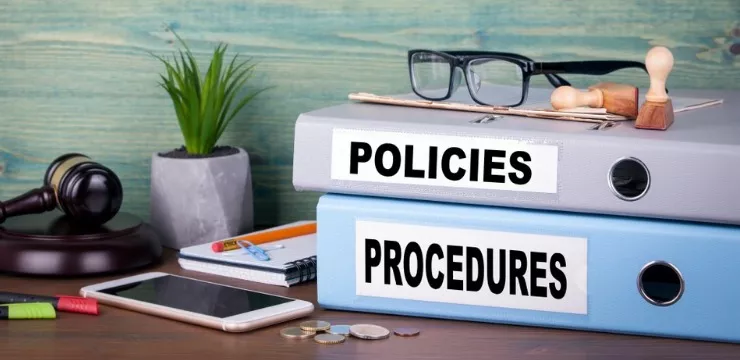
Every organization with change capacity should have its own change management policies and procedures.
These policies do not have to be extremely long or complex.
Even a few pages is enough, which means they can be created in a short amount of time.
But why have policies and procedures at all?
There are a few important reasons why you should created documented policies and procedures:
- So employees, change managers, and business leaders know how change is enacted
- They act as a go-to reference whenever anyone wants to learn about a process
- The written rules can help everyone understand their responsibilities in the case of a dispute
- They can ensure compliance to a set of expectations
Documentation is essential in every business, and change management is no exception.
If your organization has an official change capacity in any form, then you should seriously consider creating your own change management policies and procedures.
Change Management Policies and Procedures: The Essentials
Let’s look at what you should include in yours.
First of all, it should be noted that these policies should be made publicly available.
Today, it is easy to publish them on the company intranet or website, so employees can quickly access them when needed.
This also makes it easy for them to be updated as necessary.
Here are the essential sections to include in your change management policies and procedures:
Purpose
First, you should describe the core function of the document.
It should lay out in clear language what the purpose is.
For example:
- It is a document that formally describes change management expectations, processes, and procedures
- It is designed to ensure any and all changes adhere to this process
- What is included in the document
Also, you can include a general definition of the change management process – what it is.
This section should be short and to the point, without fluff.
Scope
Scope should define the boundaries of this policy.
It can include:
- Which types of processes are included
- Who should read and be included in these policies
- What circumstances to use this document
- Examples of processes that fall under the scope of this document
The scope should also be short and clear.
It should help readers quickly understand what types of changes would fall under the provisions of this document.
You may also consider including a section that points readers towards a contact person if they have any questions.
Process Description
The process description will be the most detailed section.
It should include:
- A detailed, step-by-step description of the procedure for making changes
- Who is involved at each stage
- The requirements of each stage
For example, a very simplified ITIL request fulfillment process would include:
- Create a change request
- Assign the request a priority level
- Attach supporting documentation
- Describe the process and the team members who will execute the change
- The change will be accepted, rejected, or revised
- Execute the change
- Close and review
Naturally, each step should be explained in complete detail.
When describing the request for change, for instance, make sure the reader knows vital information such as:
- What to include in the request
- Who to submit it to
- How the request should be prioritized
Any other information.
One purpose of the change management procedure document is, as mentioned, to provide a reference.
This means you should describe each step fully enough so that it can be followed by personnel.
If this section is too simple, then employees will not be able to use it to execute changes.
Roles and Responsibilities
Another section to include is change management roles and responsibilities.
This section will describe who does what.
Here are a few examples of parties to include in this section:
- Change managers and leaders
- Change initiator or requester
- Change advisory board
Under each party, include their duties, responsibilities, and their role in the change process.
This section can be designed much like a job description, with a few sentences and bullet points that describe these roles.
Supporting Sections
Other supporting sections can be included as necessary.
Such sections can include:
- Definitions
- Appendices
- Additional documentation
- Contact information
The purpose of this section is to provide definitions and information not included in other sections.
It should offer clarification on previous sections, such as the definitions of terminology or processes.
In an ITIL-based change management policy, for example, you could include definitions of:
- Request priorities
- Which changes do or do not need prior approval
- Which person to contact for different types of changes
And other information that does not neatly fit into other sections.
Conclusion
For any organization that deals with change regularly, a change management policy is essential.
Writing your own policies will help employees stay accountable.
They will know what process to follow, who to contact, and what their responsibilities are.
Ultimately, this will improve employee productivity, reduce mistakes, save time, and help changes go more smoothly.
WalkMe Team
WalkMe spearheaded the Digital Adoption Platform (DAP) for associations to use the maximum capacity of their advanced resources. Utilizing man-made consciousness, AI, and context-oriented direction, WalkMe adds a powerful UI layer to raise the computerized proficiency, everything being equal.



